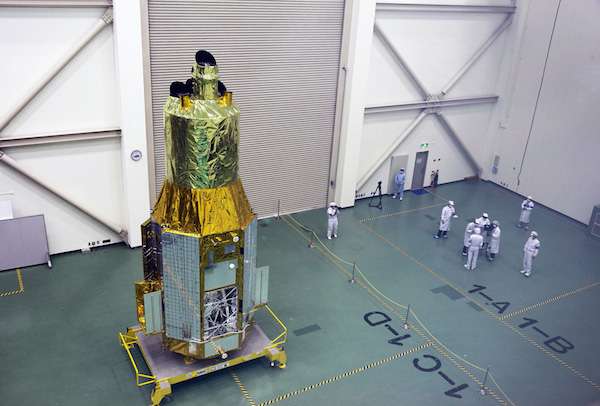ASTRO-H satellite ready for launch

On 12 January 2016, the Japan Aerospace Exploration Agency (JAXA) presented their ASTRO-H satellite to the media at the Tanegashima Space Center, situated on a small island in the south of Japan. The satellite, developed with institutions in Japan, the US, Canada and Europe, is now ready to be mounted on an H-IIA rocket for launch on 12 February.
ASTRO-H is a new-generation satellite, designed to study some of the most powerful phenomena in the Universe by probing the sky in the X-ray and gamma-ray portions of the electromagnetic spectrum. Scientists will investigate extreme cosmic environments ranging from supernova explosions to supermassive black holes at the centres of distant galaxies, and the hot plasma permeating huge clusters of galaxies.
ESA contributed to ASTRO-H by partly funding various elements of the four science instruments, by providing three European scientists to serve as science advisors and by contributing one scientist to the team in Japan. In return for ESA's contribution, European scientists will have access to the mission's data.
Traditionally, Japan's astronomy satellites receive a provisional name consisting of the word 'ASTRO' followed by a letter of the latin alphabet – in this case H, because it is the eighth project in JAXA's astronomical series. JAXA will announce the new name after launch.
About ASTRO-H
ASTRO-H is a new-generation satellite for high-energy astrophysics, developed by the Japan Aerospace Exploration Agency (JAXA) in collaboration with institutions in Japan, the US, Canada, and Europe. Its four instruments span the energy range 0.3-600 keV, including soft X-rays, hard X-rays and soft gamma rays.
ESA's contribution consists in funding the procurement of a number of items on the various instruments, three European scientists who will serve as advisors to the mission's core science programme, and one full-time scientist based at the Institute of Space and Astronautical Science (ISAS), Japan, to support in-flight calibration, science software testing and data analysis. Support to European users will be provided by scientists at ESA's European Space Astronomy Centre in Madrid, Spain, and at the European Science Support Centre at the ISDC Data Centre for Astrophysics, University of Geneva, Switzerland.
Provided by European Space Agency


















